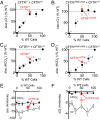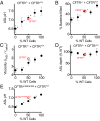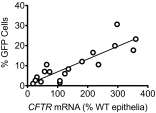Relationships among CFTR expression, HCO3- secretion, and host defense may inform gene- and cell-based cystic fibrosis therapies
- PMID: 27114540
- PMCID: PMC4868420
- DOI: 10.1073/pnas.1604905113
Relationships among CFTR expression, HCO3- secretion, and host defense may inform gene- and cell-based cystic fibrosis therapies
Abstract
Cystic fibrosis (CF) is caused by mutations in the gene encoding the cystic fibrosis transmembrane conductance regulator (CFTR) anion channel. Airway disease is the major source of morbidity and mortality. Successful implementation of gene- and cell-based therapies for CF airway disease requires knowledge of relationships among percentages of targeted cells, levels of CFTR expression, correction of electrolyte transport, and rescue of host defense defects. Previous studies suggested that, when ∼10-50% of airway epithelial cells expressed CFTR, they generated nearly wild-type levels of Cl(-) secretion; overexpressing CFTR offered no advantage compared with endogenous expression levels. However, recent discoveries focused attention on CFTR-mediated HCO3 (-) secretion and airway surface liquid (ASL) pH as critical for host defense and CF pathogenesis. Therefore, we generated porcine airway epithelia with varying ratios of CF and wild-type cells. Epithelia with a 50:50 mix secreted HCO3 (-) at half the rate of wild-type epithelia. Likewise, heterozygous epithelia (CFTR(+/-) or CFTR(+/∆F508)) expressed CFTR and secreted HCO3 (-) at ∼50% of wild-type values. ASL pH, antimicrobial activity, and viscosity showed similar relationships to the amount of CFTR. Overexpressing CFTR increased HCO3 (-) secretion to rates greater than wild type, but ASL pH did not exceed wild-type values. Thus, in contrast to Cl(-) secretion, the amount of CFTR is rate-limiting for HCO3 (-) secretion and for correcting host defense abnormalities. In addition, overexpressing CFTR might produce a greater benefit than expressing CFTR at wild-type levels when targeting small fractions of cells. These findings may also explain the risk of airway disease in CF carriers.
Keywords: cystic fibrosis; epithelia; gene therapy; host defense; pig.
Conflict of interest statement
Conflict of interest statement: M.J.W. holds equity in Exemplar Genetics, which has licensed CF pigs from the University of Iowa.
Figures





References
Publication types
MeSH terms
Substances
Grants and funding
LinkOut - more resources
Full Text Sources
Other Literature Sources
Medical

